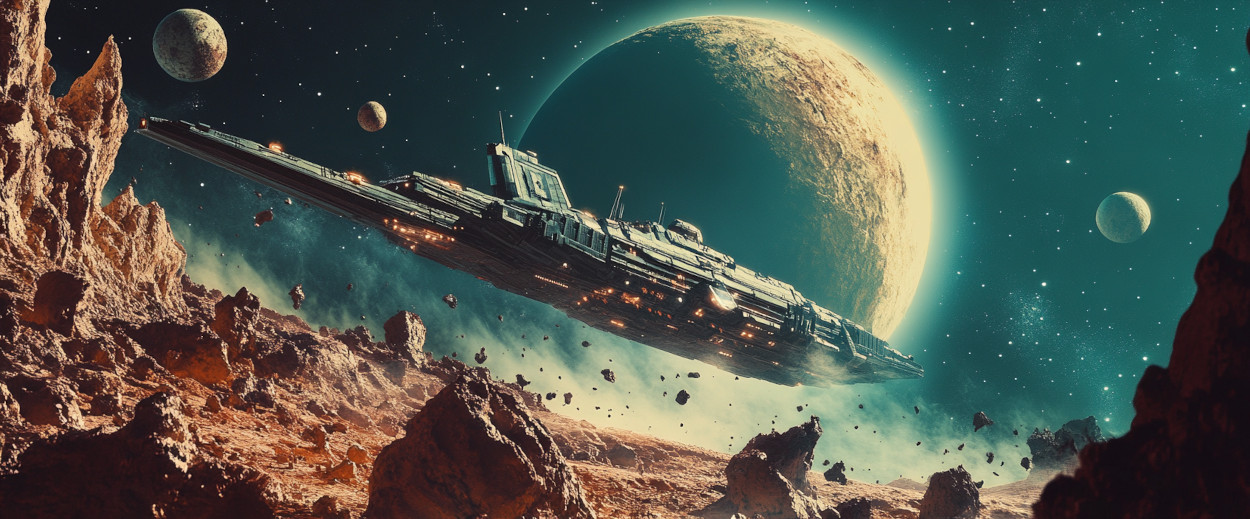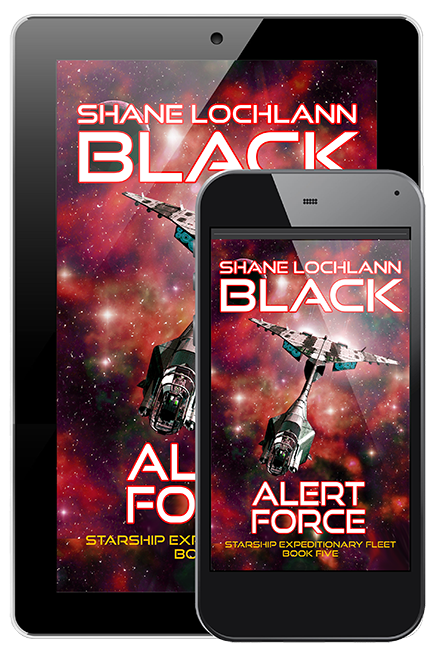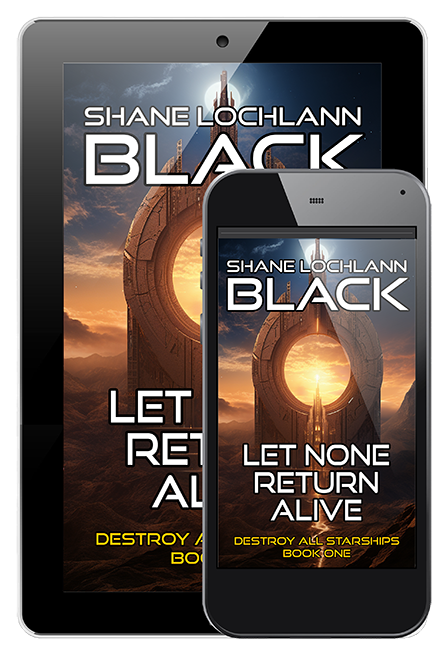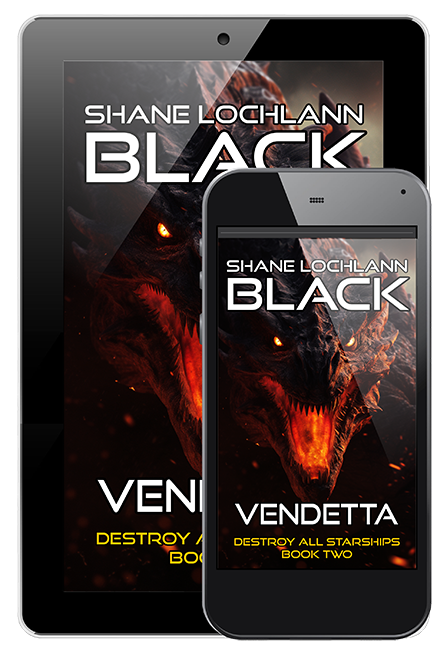
Admiral Neela Hafnetz remained on the flag bridge until the starship Rival lost her main engines. With her two heaviest escorts unable to maneuver, it was up to Saint Lucia herself to bear the brunt of the enemy onslaught. By now there were nearly thirty Kraken ships inside the Achilles defense perimeter. Although they had much lighter displacements, their weapons were superior in almost every way to the Skywatch equivalents.
Auckland’s missile launchers were exhausted. Her admittedly anemic energy banks were on the verge of burning themselves into an inoperative state, but she was still returning fire. The Talon was lost. Only a small number of her crew remained. Rival and Cherokee were adrift. The latter vessel was burning in space. Only Hallows and Emerald were left to screen their flagship against enemy fire. They fought like lions, but they were only two ships, and they were among the battle group’s lightest.
Massed proton weapons bore down on the enormous battleship and its battered and malfunctioning screens. Hafnetz stood at the main bridge conn, unwilling to move the burned and bloodsoaked body of Captain Delgado from the center chair. Shattered wreckage was strewn everywhere. Wires and scaffolding hung at odd angles from the ceiling. Small fires burned at various bridge stations. The lights flickered. The admiral watched as the barrages came in, tearing and slashing at her vessel’s armor and engines.
“We weren’t prepared. How many months and how many years did we warn them, and yet none listened?” she muttered.
“Main power fluctuating, admiral. Shall we engage the auxiliaries?”
Hafnetz looked over at the young lieutenant. How cruel that someone her age would have to sacrifice their life and all they had for something as pointless as this engagement. How cruel it was humanity would lose all that potential in a meaningless battle over nothing.
“Engage auxiliary power.”
“Aye ma’am.”
The admiral was sure she saw hope in the lieutenant’s eyes. After all, a sure-sounding order made junior officers and crew believe everything was under control. It made them believe the senior officers would protect them and make sure they got home safely. It wasn’t until the end they realized there were times when even an admiral they had looked up to since the day they first wore the uniform couldn’t save them.
Hafnetz took a deep breath, cradling her broken wrist. The deck plates shuddered with weapons impacts and detonations below decks. The admiral steeled herself for her final moments. She stared at her attackers, determined to face death as bravely as she had faced war.
How many wars? And to have it end this way?
She thought she was hallucinating when she saw one of the approaching Kraken ships disappear in the bleach-white glare of a breached fusion bottle.
Two of the medium-sized attacking vessels hesitated, desperate to get new firing solutions on the three night-black gunships that settled into position only a few hundred yards off their forward hulls. Black Six got its firing solution first and opened up with overloaded brawler cannons. The gunship known as “Negative X” pounded on enemy contact Arctic 19 like a bare-fisted cage fighter. Moments before its forward shields collapsed, the Kraken ship was torn to pieces by sprint-fired missiles. The fighters of the 994th squadron screamed past, banking in all directions for another run.
Suddenly confronted by a two-front war, the enemy formation broke in several directions, which just made things easier for Argent’s star wing. Paladin multi-role spacecraft from the 7th Strategic Air Group peeled left, launching missiles and seeker bombs at the Kraken flagship’s escorts. A vicious furball erupted as the escorts banked around to return fire. Moments later the pilots of the Fighting 16th arrived, plunging into the fray with energy banks blazing.
Shields overloaded, lightning-like energy discharges flashed and burned. Fighters spiraled out of the melee trailing atmosphere and plasma. The massed fire coordinated by Argent’s sophisticated datalink gave the Paladins and the Wildcats a huge advantage. They drove the Kraken ships to the edge of the deflection zone, opening up lines of fire for their mother ship’s main batteries. Argent’s HAVOC weapons thundered, sending fiery beams of destruction through the enemy formation again and again. Finally a shot from battery seven struck one of the heavier vessels amidships. It ruptured in a grisly brilliant fireball. The debris tumbled away into the gravity well of the Omicron singularity.
Target Arctic 11 performed a dangerously tight high-speed turn to get a weapons lock on a nearby Paladin attack craft, only to fly headlong into one of Argent’s AMAX capital missiles. The percussive shockwave from the impact knocked two other Kraken ships off course. One collided with a pursuing Paladin and fell out of formation trailing fire. The other avoided a shot from Argent’s main battery only to fly into a kinetic missile barrage fired by Red Buccaneers pilot Ensign Jerry Terrence, callsign “Moshpit.”
The gunships of Black Wing took out after a separate formation of heavier ships, trading energy blasts with them as if trying to deliberately start a bar fight with a couple of broken bottles and a handgun. This was no war of precision flying and technologically sophisticated weapons locks. Black Four, the gunship called “Hellsquare,” set the tone early by parking itself about sixty yards off the nose of one of the fatter Kraken escorts. The alien vessel achieved a six by six hard lock on the gunship’s nose, which got about as much reaction from the Argent gunship as if the Kraken crew members had been making faces out a window. A powerful blast of proton energy followed, immolating the scorpion-like spacecraft in an oval of slow burning orange and white fire. When the menacing shape of Hellsquare emerged from the flames, the war was on.
The gunship’s close-in cannons punched through space like fast-moving shrapnel through a plastic tarp. The unstable bolts of disruptive plasma crashed through the Kraken battle screens and pulverized hull plating. Lightning-like fingers of ionized destruction scored armor and shattered viewports. The ship convulsed as secondaries went off below decks. One more proton beam flashed from its main weapon and slammed into Black Four’s deflectors again. Hellsquare’s panic reactors managed to absorb all the energy this time. One exploded, knocking the gunship out of position, but not far enough to save its target. The brawler cannons fired again, and again, and again until there was nothing left but molten fire and trails of radioactive wreckage. Black Four limped away, heading back to Argent and a place to re-arm and repair, leaving a drifting funeral pyre for its enemy behind.
The scattering battle group abandoned the two capital vessels formerly at the center of the Kraken formation. One managed to come about and get a four by six lock on the Argent’s forward battle screens. Hunter’s battleship bore in, ready to go mano y mano at ridiculously short ranges. Just before the captain gave the order to launch his own DAX capital missiles, the enormous Kraken flagship erupted in white and orange flames, speared by a center of mass shot fired by Saint Lucia’s number three HAVOC battery.
The second Kraken heavy was about to engage Argent when the black-hearted pilots of the 118th came howling out of their flagship’s interdiction zone. Fourteen F-90 Superjacks brought unimaginable firepower to bear all at once. They spiraled in from numerous directions, SPECTRE beams, oxygen-compression torpedoes and Hemlock anti-matter warheads screaming from their hardpoints. The Kraken ship went into a murderous evasive spiral moments before one of the Death Maidens’ torpedoes dove more than 200 feet into its framing and pulverized at least nine decks. The golden-silver hulls of the Superjacks gleamed as they rocketed out of yet another expanding wave of destruction.
With the enemy formation broken, and Argent’s fighters and gunships engaged in mop-up operations, Zony opened a channel to the Achilles flagship.
“Argent to Commander Saint Lucia. Come in.”
There was a delay as the larger ship’s autosystems attempted to pierce the static. Finally a faraway voice answered.
“This is Lieutenant Oxfordson, speaking for Saint Lucia. We’ve sustained heavy casualties. Captain Delgado is dead. Admiral Hafnetz has been taken to the medical deck and has been scheduled for transfer to Edward Jenner. We’re in pretty bad shape, Argent.”
“Understood, lieutenant. Who is the ranking task force officer?”
“You are, sir.” More static. Zony looked up at Hunter. The captain hesitated for a moment.
“Very well, lieutenant. See to your wounded. Argent has the point. Hunter out.” Jason almost stumbled as he turned towards the force command station on the bridge. “Commander, have Zack launch two combat space patrol formations. Start with the Archangels and the Tigersharks off Flight Three. I want a Copernicus with a damage control party and a Tranquility with a medical team over to Saint Lucia right away.”
“Affirmative, sir.”
“You have the conn. I need uhh–”
“We understand, sir,” Zony said as she went to Hunter’s side to help him stand. She activated her commlink. “Medical team to the bridge.”
“Not bad for a pinch hitter, huh?” Jason said.
“Not bad at all, cap.”
 Strike Battleship Argent
Strike Battleship Argent Let None Return Alive
Let None Return Alive







































